RV maintenance and storageRV beginner
9 Things You Need to Know About Your RV’s Black Water Tank
Posted on June 30, 2021
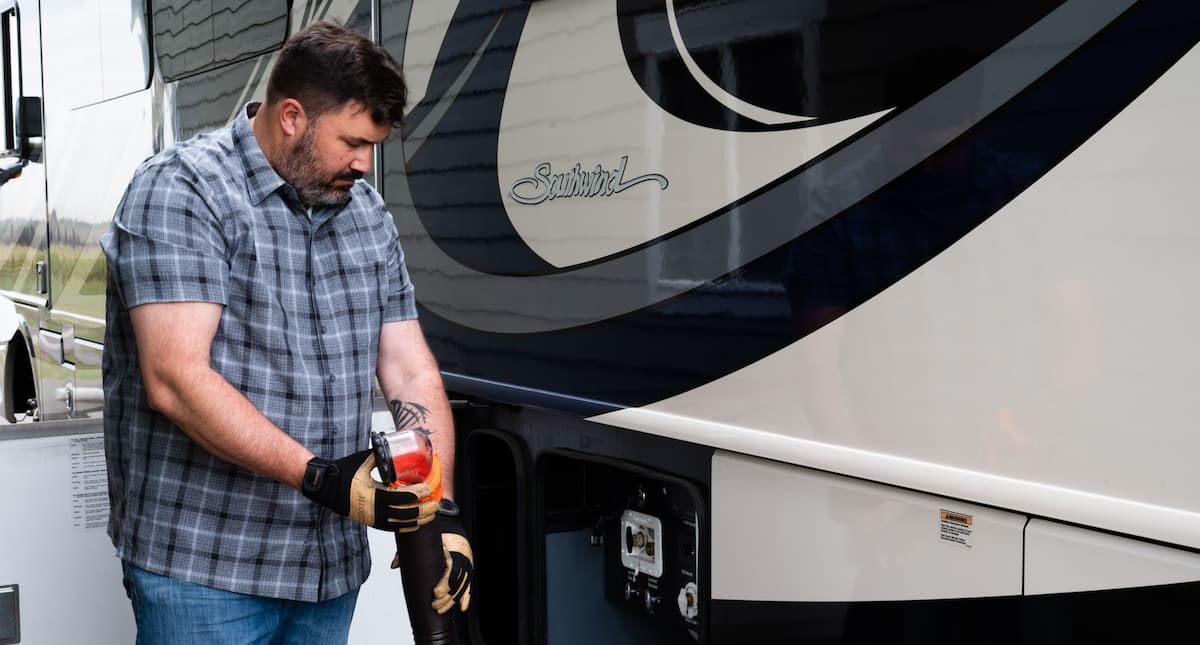
Got questions about your RV’s black water tank, but you don’t know who to ask?
We get it. No one likes talking about toilet habits.
Lucky for you, we’ve got the scoop on poop.
We’ve got the answers to your questions, so you won’t have to worry about having a Cousin Eddie moment in the campground.
This post has nine quick and dirty tips to help you feel comfortable using your RV’s black water tank.
What is the black water tank?
The black water tank is a holding tank for liquid and solid waste located in the underbelly of an RV. Only RVs with toilets have black water tanks.
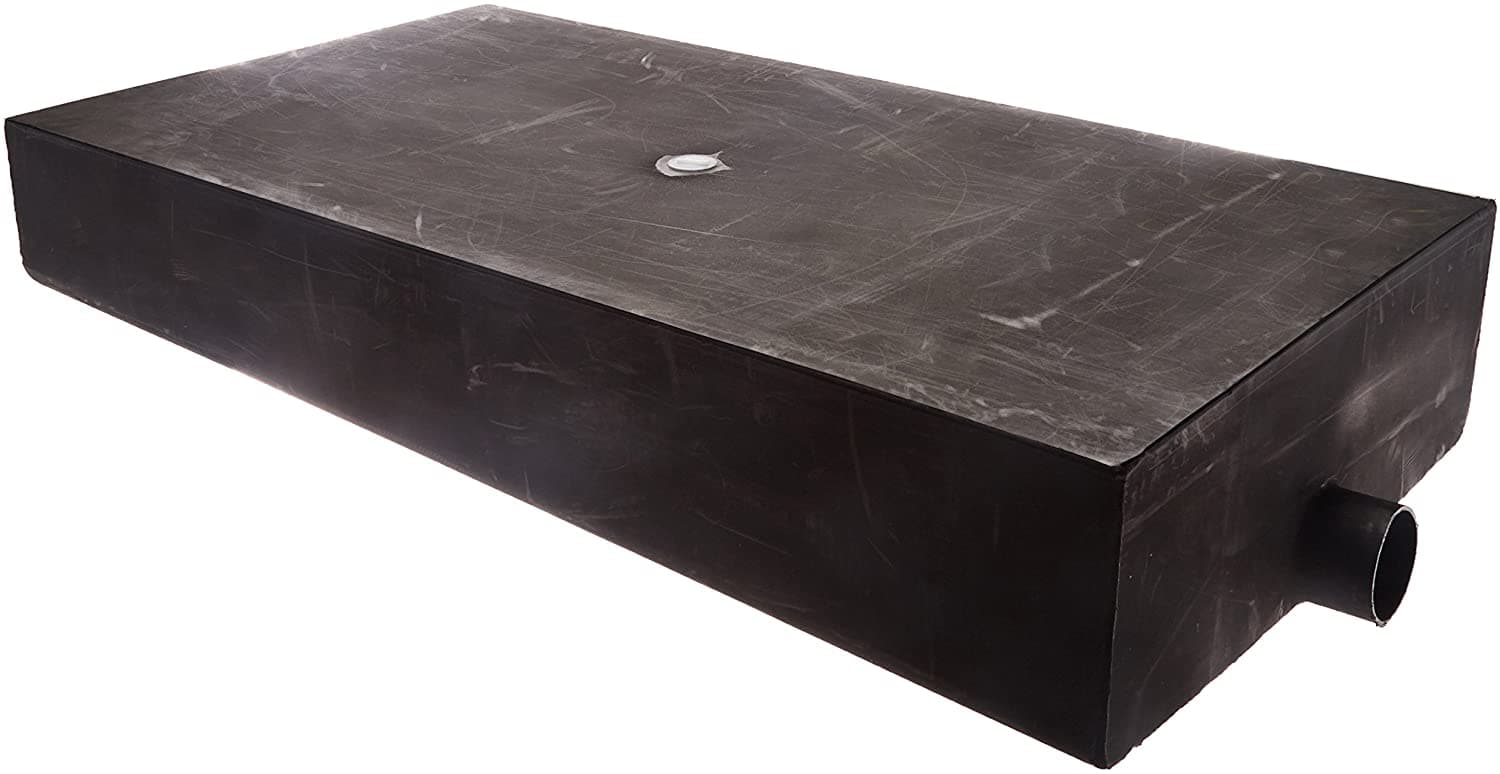
RV toilets operate differently than your toilet at home because RV toilets use a freshwater supply and a holding tank, whereas your house toilet uses a freshwater supply and a plumbing system that disposes waste into a sewer or septic system.
How is the black tank different from the gray tank or the freshwater tank?
Most RVs have three separate holding tanks: black, gray, and fresh water. Some smaller RVs may combine the black and gray tanks into one tank to save space. When RVs have combination tanks, all dirty water goes into one holding tank.
An RV black water tank holds waste from the toilet while the gray tank holds water from the sink and shower. An easy way to remember the difference between the two tanks is to picture the color of the water inside. Black tanks hold dark-colored contents, while gray tanks hold soapy or slightly dirty-colored contents.
Freshwater tanks are different from black and gray water tanks for a few reasons. Freshwater tanks hold sanitized and potable water suitable to drink. The fresh water supplies the water you use to shower, use your sink, or fill your toilet. Even though you have a freshwater tank on your RV, it’s not always necessary to fill the tank unless you want water on board for travel days or off-the-grid camping. Why?
Fresh water works two ways. You can either use a freshwater hose — sometimes called an RV drinking water hose — and bypass your freshwater holding tank by using water from a campground or RV park, or you can fill your freshwater tank and use the water on board. Unlike the black and gray water holding tanks, it’s not necessary to empty fresh water into an approved dump station because fresh water is not considered sewage.
What if you have a cassette or cartridge toilet?
Tiny trailers, truck campers, and Class B motorhomes are compact and don’t always have space for black water holding tanks. Cassette and cartridge toilets are small and don’t require an underbelly holding tank because the waste empties into a portable blank tank.
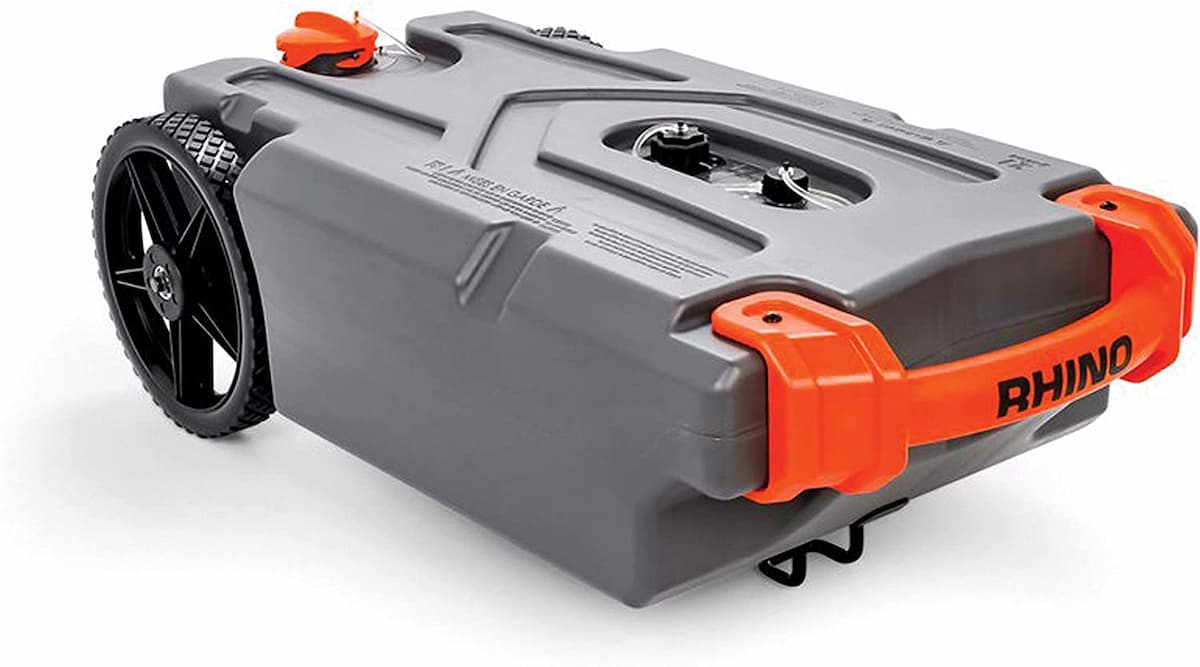
When it’s time to empty your cassette or cartridge toilet, remove the portable tank and dump it down a toilet, RV park sewer, or dump station.
How will you know when it’s time to dump your black tank?
Most RVs have sensors that help monitor the levels in your black water, gray water, and freshwater holding tanks. Typically, the sensors track fluid levels in increments or percentages. Don’t wait until your tank reads full to dump. One extra visit to the toilet could push your tank from full to overflowing. Avoid a stinky situation by dumping your black water tank when the sensors indicate 3/4 or 75% full.
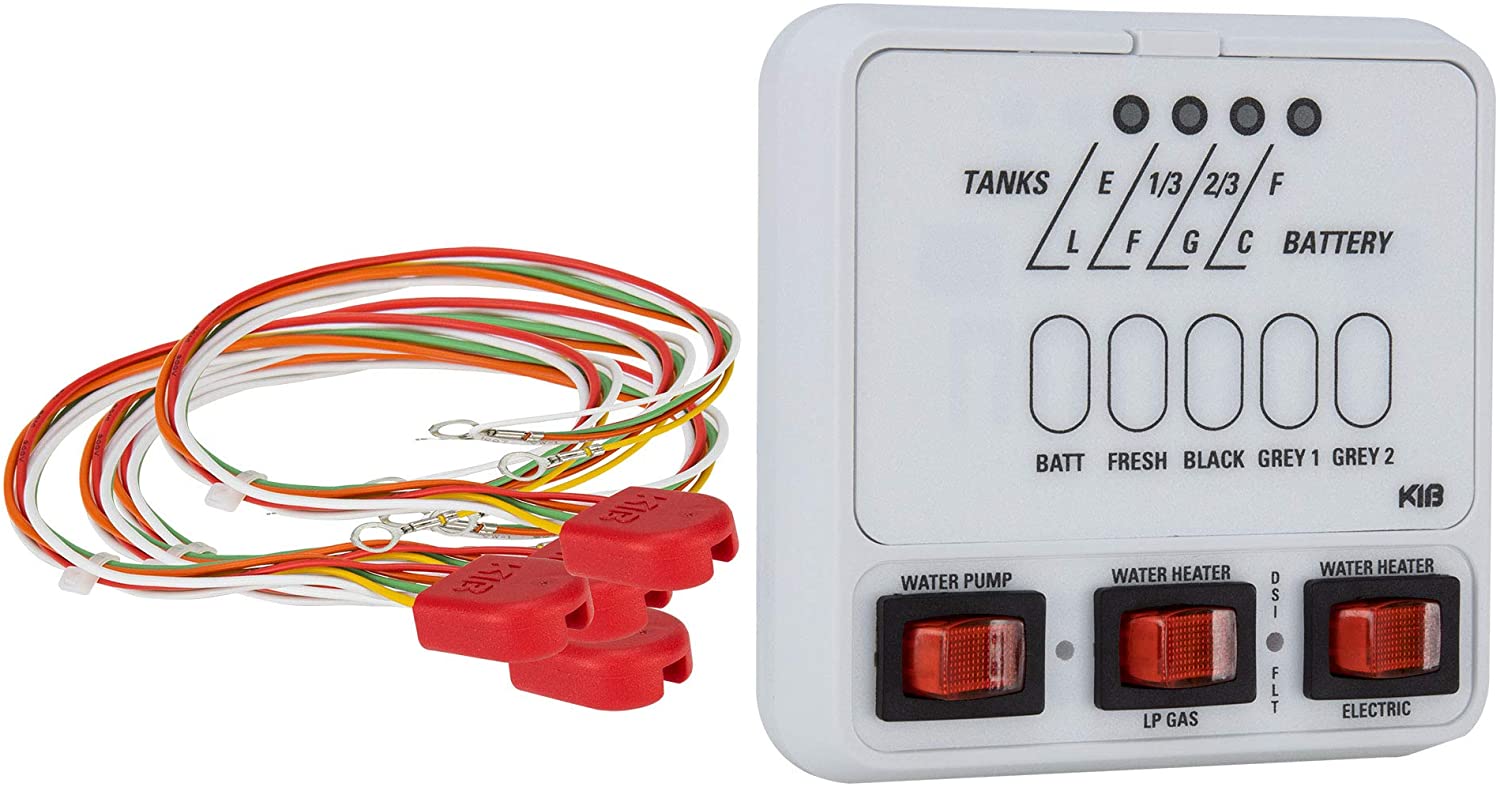
You can help monitor your tank levels by learning the size of your holding tanks. The average size of an RV black water holding tank is anywhere between 15 and 50 gallons. How often you will have to empty your tank will depend on the size and the number of people using the tank. The more people you have on board your RV, the more often you will have to dump.
Should you worry if your sensor reads full right after dumping your tank? No. Tank sensors aren’t always accurate. That’s why it’s a good idea to learn your tank-size-to-people ratio. Several things cause blank tank sensors to malfunction, but the most common problem for false readings is a wet or sticky buildup inside the tank near the sensor. Anything from a wet chunk of toilet paper to the plastic coating of a tablet tank deodorizer can stick to a sensor. While RVers like to toss around black-tank cleaning hacks, it’s better to follow your manufacturer’s suggestions for cleaning your tanks before trying a DIY tank cleaner.
What sewer supplies do you need?
Before you head out on a road trip or prep your RV for rental, it’s a good idea to get some basic black tank supplies.
Gloves: Disposable water-resistant gloves should be a part of everyone’s black tank kits. When you empty your tanks, you will most likely come in contact with unclean surfaces. Even when surfaces look clean, they might be dirtier than you think.
Closed-toed shoes: Never empty your tanks wearing flip-flops or sandals. Why? Aside from the obvious, the area around most dump stations is wet. Flip-flops can get stuck in the mud or slip on wet surfaces. Closed-toed shoes with traction will help you move better and protect your feet from any unfortunate splashes.
Disinfectant spray and wipes: Keep your disinfectant spray and wipes handy while you empty your tanks. Even though you’ll want to wash your hands with soap and water after dumping, wipes can help you clean off sewer caps and other surfaces near the dump station, as well as provide a quick cleanup before washing your hands.
RV sewer hose: Most RV sewer hoses have retractable accordion shells. The hoses stay relatively small during storage and stretch when it’s time to use. Sewer hose kits typically come with a 15-foot (4.5-metre) hose with swivel fittings and storage caps. If you need a hose with more length, consider purchasing an extension.
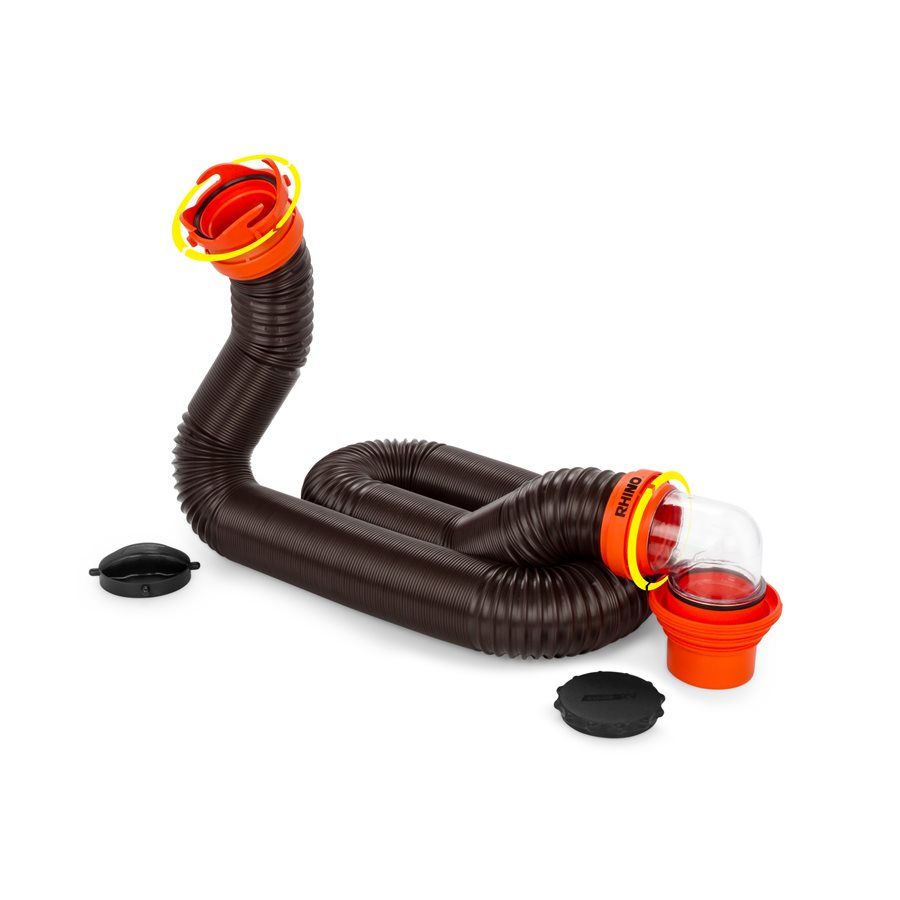
Translucent elbow and adapter: A translucent elbow and adapter connect sewer hoses to dump station pipes. The clear elbow allows you to see when the liquid stops flowing, and the adapter helps attach the hose to different size threads on some dump station pipes.
RhinoFlex Sewer Fitting Wrench: A sewer-fitting wrench wraps around the sewer hose and helps remove hard-to-budge hoses.
Sewer Saddle Bag: The Sewer Saddle Bag is a gadget that straddles your sewer pipe and helps keep it in place when it’s time to empty your tank. Not all dump station pipes have working threads, and it’s sometimes hard to keep the sewer hose connected when it’s time to dump. For solo RVers who don’t have an extra hand — or foot — to hold the pipe in place, the Sewer Saddle Bag is a game changer.
Storage solution: Some RVs have a built-in pipe or bumper designed to store sewer components. For RVers who need a portable sewer-hose storage solution, purchase an easy-to-identify storage bag.
How do you empty the black water tank?
Feeling a little apprehensive about emptying your RV black water tank? Almost all newbie RVers worry about their first dumping experience, but thankfully, emptying your tank is easier than you think.
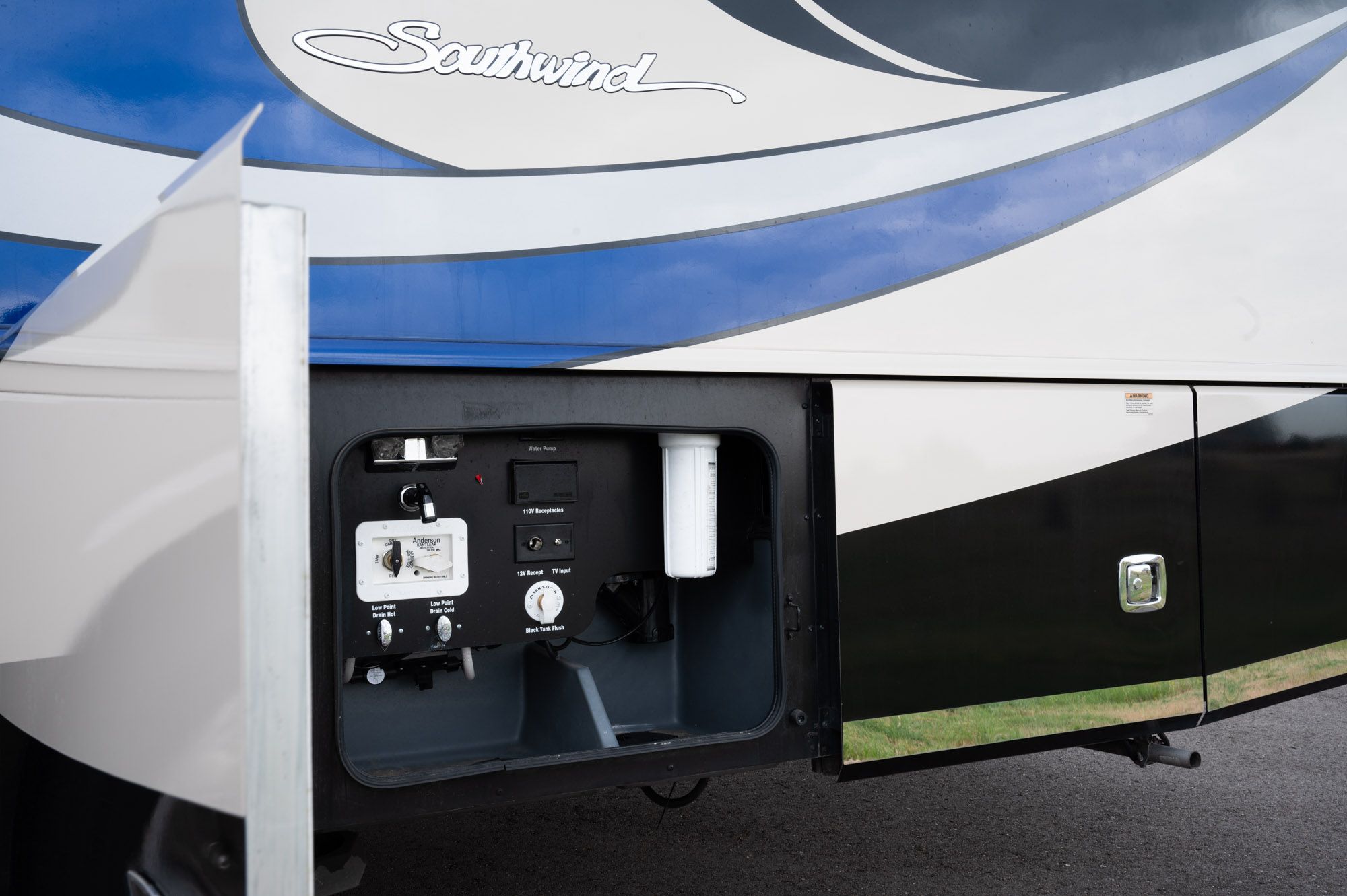
Emptying the black water tank
- Park the RV close enough to the dump station so that your hose can reach from the RV to the sewer pipe without being completely stretched out.
- Set out your black water tank dumping supplies.
- Avoid stepping in any wet or muddy areas.
- Put on your disposable gloves.
- Remove the sewer hose storage caps from both ends of the sewer hose.
- Make sure the black water holding tank valve is closed.
RVezy pro tip: The holding tank valve releases liquid from the black water tank. The end cap covering the holding tank outlet should not be used as a substitute for a closed black water holding tank valve. - Remove the end cap covering the holding tank outlet.
- Attach the bayonet end of the sewer hose fitting onto the holding tank outlet.
- Attach the outlet end of the sewer hose to the dump station’s sewer pipe. If you have a translucent elbow or a sewer pipe adapter, attach those items before connecting the outlet end of the sewer hose to the dump station’s sewer pipe.
- Double-check that the sewer hose connection is secure and will remain in place while releasing liquid.
- Slowly pull the black water holding tank valve handle until the valve is completely open.
- Wait until the tank is drained.
- Close the black water holding tank valve.
Before you disconnect and store your sewer hose, flush your sewer hose with clean water using one of the following steps.
Flushing the sewer hose
Some dump stations have a non-potable water hose located next to the sewer pipe made for rinsing sewer equipment and should not be used to fill your RV’s freshwater holding tank. If a hose isn't available, or you are dumping your tanks at your campsite, rinse your sewer hose with the water at your site.
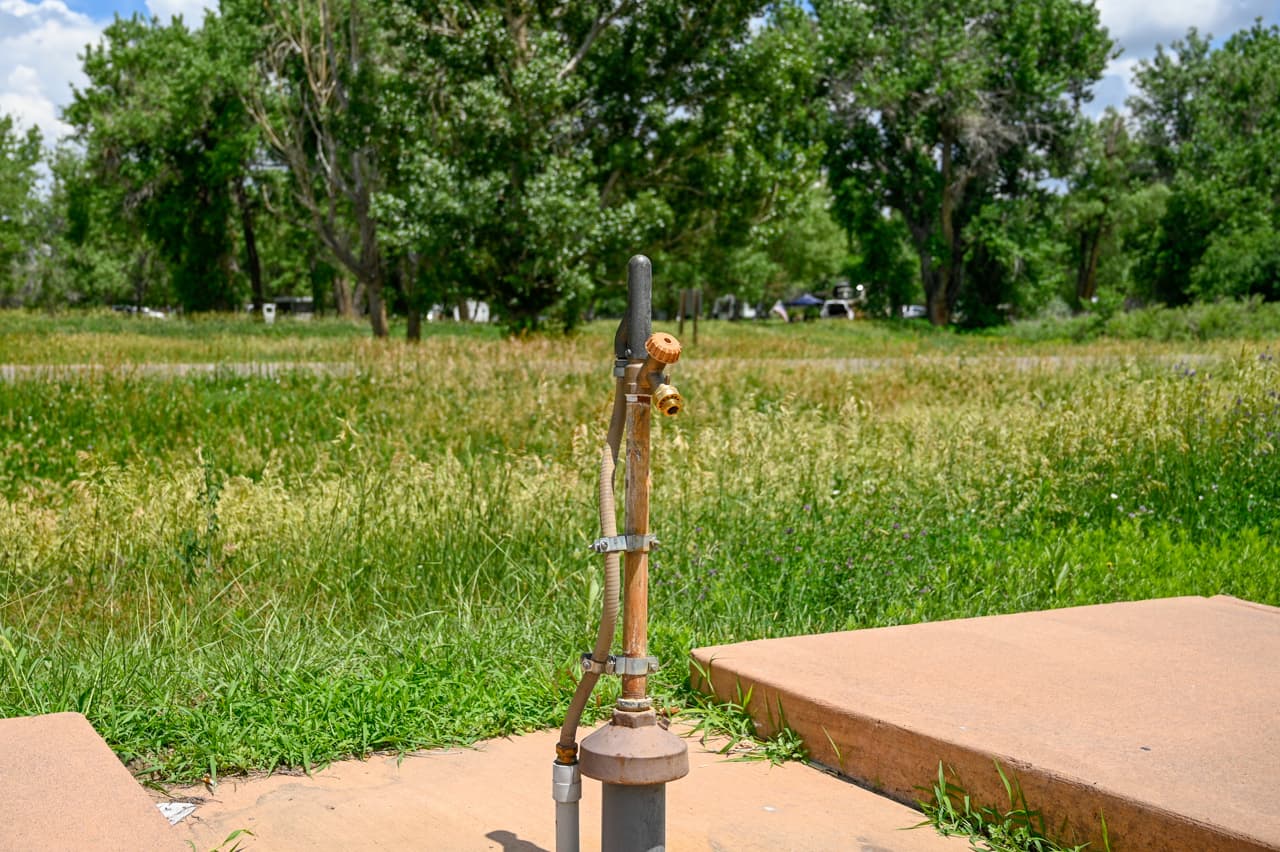
Never use your drinking water hose to rinse out your sewer hose. Bring a separate hose to use with your sewer equipment.
Freshwater flush method. After closing your black water holding tank valve, disconnect the bayonet end of the sewer hose but not the outlet end connected to the sewer pipe. You may want to place the end cap back on the holding tank outlet before you use a hose to run water through the sewer hose.
Refill method. Depress the toilet pedal and fill the black water tank with fresh water. After the sensors read 3/4 or 75% full, repeat steps 9 through 11.
Gray water flush method. Dump your gray water tank after dumping your black water tank. Like the refill method, make sure to fill your gray water tank until the sensors read 3/4 or 75% full. Slowly pull the gray water holding tank valve handle until the valve is completely open. After the gray water tank is drained, close the gray water holding tank valve.
Black tank flush method. Some RVs have a black tank flush, which helps to power wash the inside of a black water holding tank. Black tank flushes require a few extra steps, which can often be manufacturer specific. If your RV comes equipped with a black tank flush, it’s best to follow the instructions outlined in your owner’s manual.
Finishing up
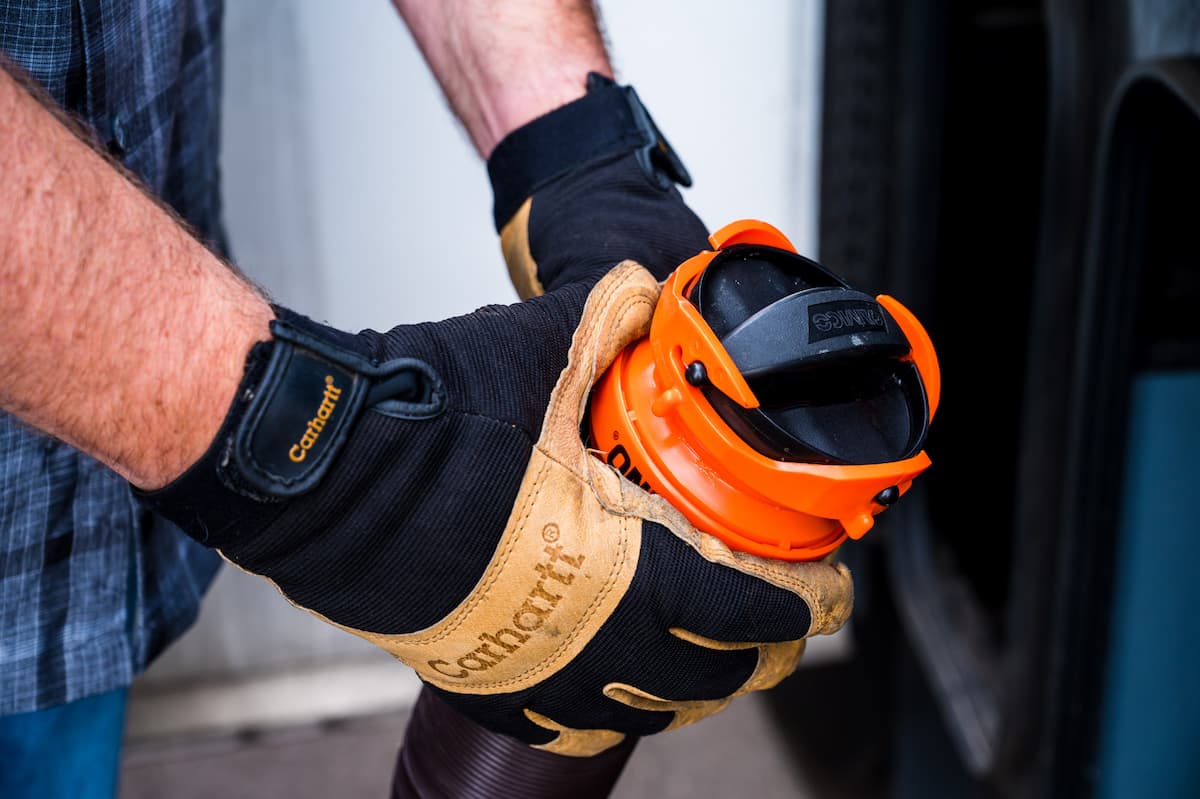
- When you are done flushing the sewer hose, disconnect the outlet end of the sewer hose from the sewer pipe and compress the hose together. If you used a translucent elbow and adapter, remove these parts from the sewer hose.
- Disinfect the fittings or any parts that might have come in contact with the black water.
- Replace the end cap covering the holding tank outlet. You might have done this step if you followed the freshwater flush method. Feel free to remove the cap for sanitation and replace it for storage.
- Replace the storage caps on both ends of the sewer hose.
- Store your sewer hose and dumping supplies.
- Remove your gloves and wash your hands.
See cleaning and maintaining your black tank for black water tank cleaning tips.
Where do you go to dump your tanks?
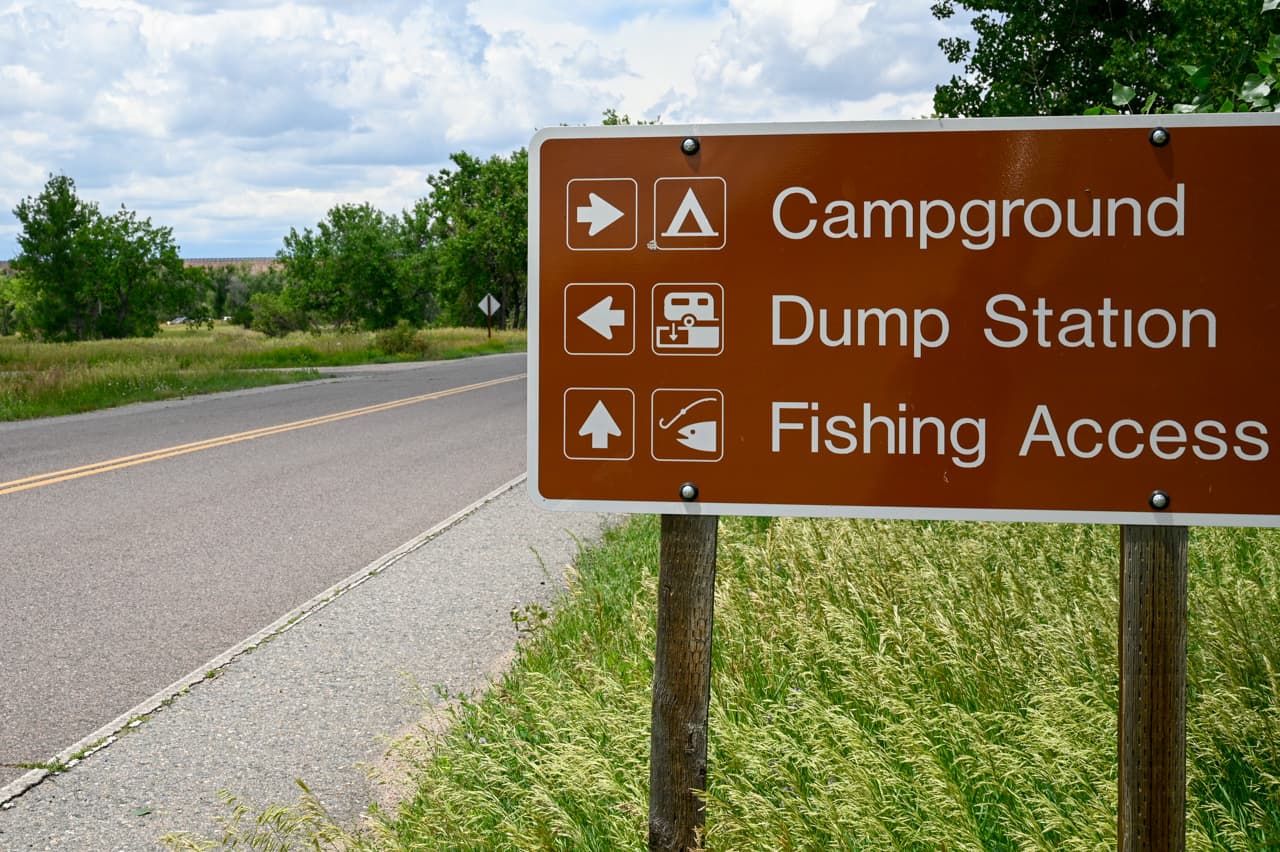
Are you ready to hit the road but need some guidance on where to find a dump station near you? You can find the best resources right at your fingertips. Many RVers rely on mobile RV apps to help them locate dump stations because apps typically have up-to-date closure and pricing information. Some dump stations, like some parks and campgrounds, operate seasonally, depending on temperatures. Apps often post real-time user experiences and provide contact numbers, so it’s easy to verify if a dump station is open or closed for the season.

Privately-owned RV parks and campgrounds: Most privately-owned RV parks and campgrounds have on-site dump stations for campground guests. Newbies who book sites with full hookups can practice dumping their tanks at their own sites instead of using the dump station. The benefit to full hookup sites is that you can take your time, learn how to operate your black tank, and dump as often as you need to.
State parks, provincial parks, and national parks: Many state, provincial, and nationally-run parks in Canada and the U.S. have dump stations and permit registered campers to dump for free.
Rest areas and welcome centers: Some rest areas and welcome centers have free or pay-per-use public RV dumps.
Sanitation facilities: Water treatment and sanitation facilities sometimes have pay-per-use public dump stations.
Truck stops: Love’s Travel Stops and Pilot Flying J Travel Centers have RV-friendly facilities scattered across the U.S. Both Love’s and Pilot Flying J have downloadable apps to help RVers locate RV-friendly locations with dump stations.
Honey wagon services: Don’t feel like dumping? Look for a honey wagon service to do the dirty work for you. Honey wagon services, often operated by waste management companies, send sanitation trucks to your home or campsite and pump your tanks for you.
Tank service for rented RVs: Did you know that some RVezy hosts offer cleaning services as an add-on? If you’d rather spend more time on the road and less time cleaning, ask the host about adding on a tank-cleaning service.
View RV rentals near you
Black tank tips you need to know
Always close the holding tank valve. Full-hookup campsites make dumping your black water tanks a breeze. Once you’ve got your sewer hose attached, it might seem like a good idea to keep the holding tank valve open to let the water go directly into the sewer, but it’s not. Smells from the sewer will creep inside the RV through the open valve and make for a stinky stay.
Use a lot of water. Water! Water! Did we say water? The one place you won’t want to conserve water is inside the black water holding tank. Water helps flush everything down better, and when mixed with a holding tank treatment, water interacts with the treatment and breaks down RV toilet paper and solid waste. Before using the toilet, fill the bowl with water at least halfway. When you flush, everything should go down much easier.
Use RV toilet paper. RVers often debate whether or not it’s necessary to use RV toilet paper. Some people say that septic-friendly toilet paper is just as safe as RV toilet paper, but some manufacturers disagree. Your best bet? Stock your RV with the toilet paper the manufacturer suggests.
RVezy host tip: Post a laminated or framed sign in the bathroom with tips for using the toilet.
Don’t flush anything other than toilet paper. Flushing anything other than human waste and toilet paper down the toilet will clog the tank and create problems. Expensive problems. Keep a small trash can with a lid next to the RV commode, and line the can with a trash bag. If necessary, leave small waxed-lined paper sacks next to the trash can to make it easy to dispose of sanitary items discreetly.
Be aware of campground requirements. Some RV parks and campgrounds have local or municipal regulations that require campers to keep sewer hoses stowed or off the ground when not in use. A sewer support will help keep your hose off the ground, protect it from damage, and help move liquids when it’s time to dump.
Cleaning and maintaining your black tank
As with any RV system, it’s important to avoid damaging your RV by following your manufacturer’s suggestions for cleaning and maintaining the black water tank. Always consult your owner’s manual before using a new product or trying a cleaning hack or home remedy.
Black water tank treatments neutralize odors and help to keep your RV commode clog-free. RVezy hosts are raving about Happy Campers natural RV holding tank treatment and deodorizer because it’s organic, biodegradable, and environmentally friendly. A tiny scoop helps keep your black water and gray water tanks in tip-top shape.
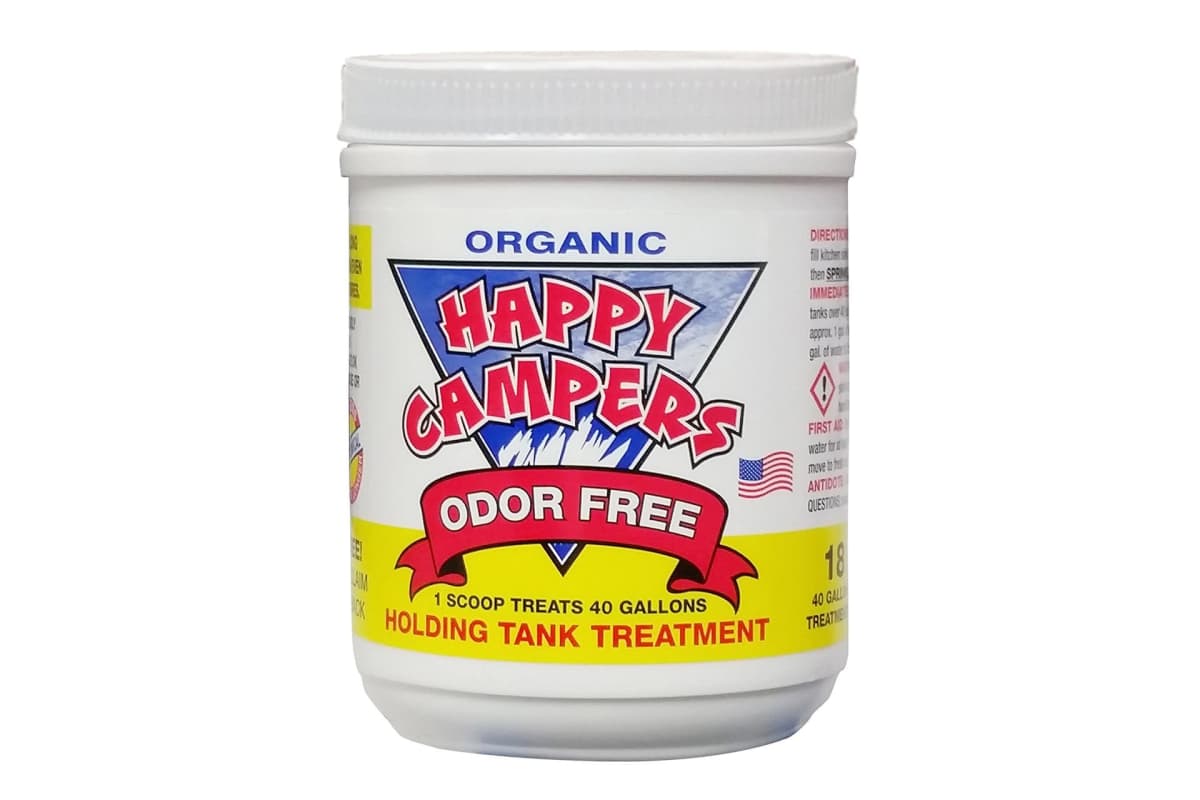
Do you have buildup on your sensors or a clog in your black water tank? Some RV owners believe that dumping ice cubes into a partially full black tank before driving can help knock debris off of the sensors. Other RV owners dump Calgon or Dawn Dish soap into the tanks. While these hacks might work, we discourage you from putting anything down your tank without consulting your owner’s manual or manufacturer first.
Conclusion
Taking care of the RV black water tank isn’t hard once you familiarize yourself with the process. Although black water tank bloopers happen, they aren’t as bad as you might think.
Remember, the RV community is knowledgeable and helpful, so if you need assistance or have questions related to your RV, feel free to reach out. Most campground hosts, RV park staff, and friendly neighbors are happy to lend a hand.
Are you renting an RV from RVezy? Refer to the materials left by the host or contact the host with your questions. Do you suspect that your black water tank isn’t working properly? Make sure to contact the host for help troubleshooting the issue; it might be a simple fix.
